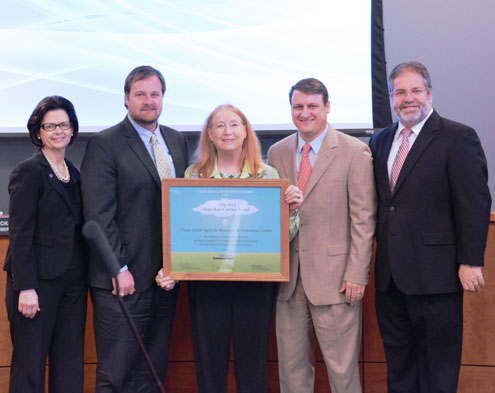DALLAS – The Texas A&M AgriLife Research and Extension Center in Dallas has received statewide recognition for developing the first WaterSense labeled demonstration home in Texas.
The home is located on the grounds of the center, 17360 Coit Road.
The WaterSense home received a 2013 Texas Rain Catcher Award. Announcement of the award, which is presented by the Texas Water Development Board, was made May 1 in Austin.
The award recognizes excellence in the application of rainwater harvesting systems in Texas through promoting technology and educating the public, according to board information. Recipients display “excellence in rainwater harvesting” in Texas in educational, government, residential and non-profit/research categories.
“The Texas A&M AgriLife Research and Extension Center is to be commended for implementing new technology that promotes rainwater harvesting and the benefits of water conservation,” said board member Kathleen Jackson. “This demonstration project provides Texans with yet another invaluable tool for conserving water.”
Board chairman Carlos Rubinstein added that rainwater harvesting is an important tool toward water conservation in Texas.
“We need individuals, cities, agriculture and industry all conserving for the long-term future of Texas,” he said. “We applaud this year’s recipients for their dedication to promoting conservation through the exploration of creative ideas.”
The Dallas center’s WaterSense home was completed in March of last year in partnership with U.S. Environmental Protection Agency Region 6 and the City of Dallas Water Utilities, said Clint Wolfe, urban water programs manager for the center.
According to the EPA, WaterSense is an agency partner program that emphasizes “saving water and protecting the environment by choosing WaterSense labeled products for the home, yard and business, along with taking simple steps to save water each day.”It estimates that WaterSense homes use 40 percent less water than the average home, saving about 50,000 gallons a year for a family of four.
“Our facility is the first ever to receive certification as a renovation project and the first WaterSense home to have a rainwater harvesting system as one of its water-saving features,” Wolfe said. “The system provides an efficient alternative source of irrigation by using captured rainwater for landscaping.”
He said the rainwater harvesting system for the WaterSense home consists of a 1,000-gallon polyethylene tank with a first flush diverter and fill tube. The tank provides water to seven drip irrigation zones and two spray zones outfitted with a 1-horsepower self-priming pump.
Overflow from the rainwater system drains into a dry creek bed in the back of the house and irrigates a rain garden. The home’s garden area consists of low-water-use native and adaptive plants, and the landscape has been designed to be sustained solely by irrigation from captured rainwater.
“The WaterSense labeled home was a top attraction at the WaterSense event held at the center in March to recognize World Water Day and national Fix a Leak Week,” Wolfe said.
More than 800 people from Dallas and surrounding cities were able to tour the home as part of event activities.

“The WaterSense home and nearby multi-family dwelling, which we are also hoping will receive WaterSense designation, serve as working models to demonstrate to visitors just how easy water conservation can be,” Wolfe said.
He said in addition to rainwater harvesting, the center’s WaterSense-oriented dwellings provide hands-on learning opportunities in areas such as hot water on-demand systems, water-efficient faucets and fixtures, low-water-use landscaping and irrigation, and rain garden design.
“Preserving water resources and maximizing water-use efficiency is a major emphasis of the Dallas center’s research and educational programs,” said Dr. Mike Gould, center director.
“We’re proud the Texas Water Development Board has recognized us for our efforts,” Gould said. “Management of our limited water resources is one of the highest priority issues affecting urban residents. Here at the center we are looking into a wide array of technologies and methods of conservation that will work not only for today but also into the future, as metropolitan centers continue to grow and limited resources become even more strained.”
He said in addition to rainwater harvesting, water-oriented efforts at the center include lawn and landscape water conservation, resource-efficient landscapes, irrigation system design and management, rain gardens, porous pavements, green roofs and wetlands, protecting urban water sources from erosion and sedimentation, promoting responsible chemical use in urban landscapes, and the use of alternate irrigation water sources for urban landscapes.